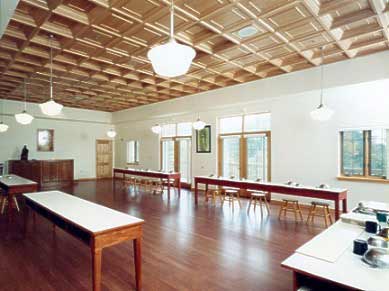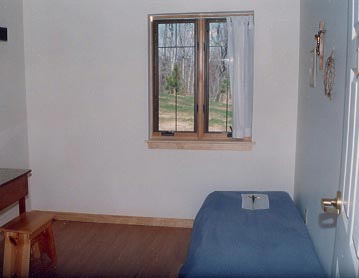|

|
|
|
BELLTOWER
The architecture for our simple bell tower is again modeled on the
one at San Damiano monastery in Assisi. Bells connected with divine
services go back in Christianity to about the fourth century. When
our Father St. Francis visited the Near-East during his wondrous
odyssey of 1219, he became passionate about reproducing Muslim
fervor for public prayer. He listened to the crier (muezzin) in his
minaret and watched these non-Christians prostrate in profound
adoration; and he straightway brought their custom, in Christian
form, back to his hometown and territory. Today's Angelus is a
direct descendant of his effort! Our two tower bells, Maria and
Chiara, announce not only the Angelus, but the greatest moments of
the day, our Eucharistic celebration as well as the seven daily
hours of the Divine Office, the Liturgy of the Hours. |
 |
 |
QUADRANGLE
Here at the center of the residential area of our monastery is the
"cloister", our "garden enclosed". It symbolizes for us the monastic
way to union with God: a life truly ordered for his glory. The
cross-formed walkway reminds us that it is through the redemptive
suffering of Christ and our own sharing of his Passion that the
world is brought to peace and the beauty of love. Like our Father
St. Francis and our Mother St. Clare, we shall delight in the
loveliness of nature, finding the face of God reflected in each
flower and leaf. Thus shall our hearts be purified for entering into
his Eucharistic Presence as we make our way daily to the monastery
choir that completes the circle of the cloister and is the true
center of our lives |
REFECTORY
The monastic refectory, where meals are taken in silence while the
spirit is nourished by spiritual reading is indeed another Cenacle.
Because the Eucharist was instituted in the context of a meal, the
connection between our sanctuary and the refectory is profound.
Architecturally they have been placed across from and in view of
each other on the quadrangle of the building. A connecting length of
sidewalk accentuates their sacred and complementary functions. |
 |
 |
COMMUNITY ROOM
Communing with God and communing with one another are the
partnered expressions of our enclosed contemplative life. From both
we seek to commune with all the people of God's world. The very name
community room bears special witness to the sisterhood to which we
are called. This multipurpose room reflects so many aspects of our
life in common: recreation, work projects, communal discussions,
classes, and more. |
MONASTIC CELL
The term cell, so ancient in monastic usage, has, unfortunately,
been given a pejorative meaning in our day. It derives from the
Latin cellula - a very small room. It is a little portion, private
to each sister, reflecting the simplicity and purity of our life
with Christ. This is her secret trysting place with the Beloved, a
little alcove in the King's Rooms. Besides being a place for rest at
the end of a busy day, it is a private oratory for contemplating the
Word of God, and sometimes a scriptorium for study and some forms of
quiet work. Small by worldly standards, it is as spacious as the
heart of its occupant. |
 |
 |
KITCHEN & BAKERY
The sister-cook exercises a maternal-like care over her kitchen
duties as Mary over her household at Nazareth. Using the many gifts
of God's creation, she shares daily in his creativity in the
preparation of simple nourishing meals. Bethlehem means 'house of
bread." The work of the sister-baker in preparing our daily bread, a
morning portion and an evening repast, is a sacramental sign of the
Eucharistic meal provided by the Bread of Life himself. Monastic
menus follow closely the feasts and fasts of the Liturgical Year.
This rhythm, pulsing in the heart of the Most Holy Trinity, pulses
through every aspect of a given day. |
| |
|
| |
|
|
|